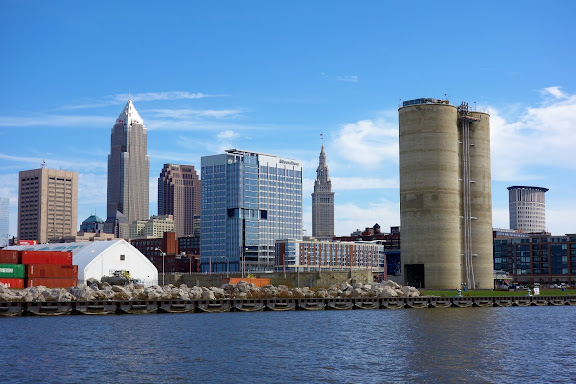Back in early November when I took a drive to Wendy Park, I also drove through Cleveland's Ohio City neighborhood to snap a few photos of one of the neighborhood's most famous... or infamous... landmarks, the Franklin Castle. The 19th century mansion has been called "the most haunted house in Ohio".
The house, which is on the National Register of Historic Places, was built between 1881 and 1883 on Franklin Boulevard for Hannes Tiedemann, a wealthy German immigrant, and his family. In 1891 his fourteen year old daughter daughter died of complications from diabetes. Just a few weeks later his elderly mother died. In the next three years three more of his children reportedly died. Supposedly to assuage his wife's grief over these tragedies, Tiedemann had extensive additions to the house built, including a fourth floor ballroom and turrets with gargoyles which gave the mansion its castle-like appearance. In 1895 Tiedemann's fifty-seven year old wife died, and a year later he sold the house. In 1908 Tiedemann died.
Unfounded rumors swirled around Hannes Tiedemann... that he had murdered his wife (he married a much younger woman shortly after his first wife's death)... that he hung his mentally-ill niece from the ceiling rafters (or was she really his illegitimate daughter?)... that he killed a servant with whom he was having an affair.
Between 1921 and 1968 the castle housed a German cultural organization. Stories of espionage and more murders were invented.
In 1968 the mansion was purchased by the Romano family. They reported numerous sightings of ghosts, and unexplained noises. They even asked a priest to exorcise the house. He refused to do so, but supposedly told them that he felt an evil presence and that they should move.
In 1974 the Romanos sold the house. The subsequent owner gave haunted house tours.
In 1984 the house was bought by Michael DeVinko, the last husband of Judy Garland. He spent a fortune renovating the castle and even tracked down some of original furnishings. He sold the house in 1994. There have been numerous owners since then, and it is now owned by a recording company.
The stories of ghosts include the sound of a crying baby, and a woman dressed in black who appears in the upper window of the front turret. While many of the tales surrounding Franklin Castle are surely the product of gossip and overactive imaginations, it's interesting to ponder if this old mansion is indeed inhabited by unhappy spirits.


























































